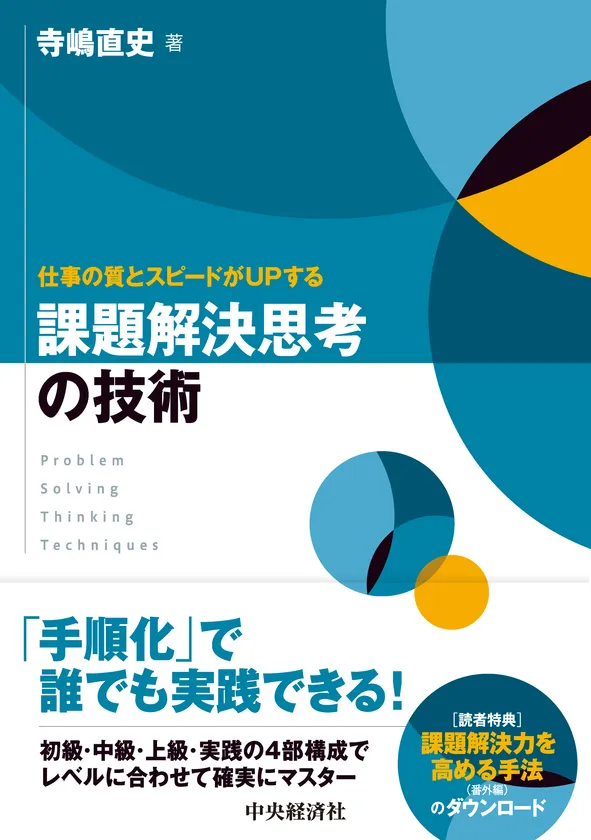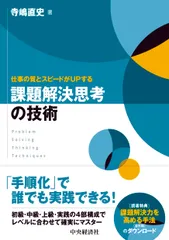Learn how to think in order to survive in the age of AI! Publication of the book "Problem-Solving Thinking Techniques to Improve Work Quality and Speed
Learn practical methods by professional consultants in the steps of Beginner, Intermediate, Advanced, and Practical.
株式会社レヴィング・パートナー
Naofumi Terashima, Representative Director of Leving Partner, Inc., a turnaround, PMI, and branding consultant, will release "Work Quality and Speed Will Increase: The Art of Problem Solving Thinking" (Chuokeizai-sha, Inc.) on March 11, 2025.
The book will be available at major bookstores nationwide and on Amazon.com.
Amazon address: https://amzn.asia/d/hcT6T58

Cover Cover
Book outline
Title: Problem-Solving Thinking Techniques to Improve Work Quality and Speed
Author: Naofumi Terashima
Publisher: Chuokeizai-sha
Format: A5 size, 236 pages
ISBN: 978-4-502-53161-3
Price: 3,190 yen (tax included)
Release date: March 11, 2025
Book contents
■Why does the "Thinking Process" seem so difficult?
The subject of this book, "problem-solving thinking," has other similar terms such as "problem-solving thinking," "logical thinking," and "logical thinking," all of which mean "thinking in a logical way," which is quite natural and something many people do in their daily lives.
However, when we hear these technical terms, we tend to feel that they are very difficult and think that they are specially mastered by a few smart people or that they are too difficult for us to master.
In fact, many people have read books on thinking methods and have at one time or another tried to master problem-solving thinking or improve their thinking ability. However, in the end, I think that the majority of people remain in a state of confusion and are unable to master it, saying things like, "I think I understand it, but I don't really understand it," or "I don't know how I can master it or how I can become proficient at using it.
The reasons why they end up in this situation are as follows.
■ Reasons why you cannot master the Thinking Method even if you read books related to the Thinking Method
(1) Methods and procedures for learning are not sufficiently shown.
(2) It is unclear what the state of "problem-solving ability" is and what the goal is
(3) Thinking methods presented are partial, and it is unclear in what situations they are effective.
(4) The book is mainly written, with few charts or examples, and it is difficult to visualize the situation in which the method will be used.
(5) The book focuses on frameworks rather than thinking methods.
(6) The author of the book may not have a sufficient understanding of the Thinking Process, and the contents of the book may not always show the correct Thinking Process.
In this way, the Thinking Process in books is unclear as to "what is the correct answer," and not everyone understands "the goal to be attained" and "the methods and procedures to reach the goal.
I think many of you are wondering, "Am I the only one who can't master the Thinking Process?" However, most people are in the same situation, and in fact, many of Terashima's fellow consultants have not been able to master the Thinking Process.
Therefore, this book solves the problem of the Thinking Process, which cannot be understood in previous books, and comprehensively organizes the Thinking Process to be used in various situations to solve readers' problems.
■Features of this book
(1) Detailed explanation of "problem-solving thinking," which improves problem-solving skills, increases the speed and quality of work, and can be easily practiced by anyone
(2) Composed of four parts: Beginner, Intermediate, Advanced, and Practical, so that readers can proceed through the book according to their level.
(3) Methods to solve all problems related to thinking, such as "three major inadequate thoughts," "lack of thinking," "narrow-mindedness," "shallow thinking," and "hard-headedness," are described.
(4) Teaches techniques and thinking methods for speedy and high-quality implementation of complicated tasks, such as the "Three Laws of Thinking Kaup" and the "Reasoning Method
(5) Provides easy-to-understand illustrations and case studies so that readers can immediately put them into practice at their workplaces
(6) Introduces rational content that follows the rules of the brain based on the findings of brain science
In the age of AI, expertise will no longer be a weapon. However, even if you search for a solution with AI, it will only provide you with general solutions, making it difficult to derive the optimal solution that solves the true cause of the other person's problem.
On the other hand, if you master problem-solving thinking, you will be able to customize a variety of information and make the best proposal for the other party, which cannot be derived by AI.
In other words, problem-solving thinking is a skill that will help you survive in the age of AI.
By using this book as a recipe, anyone can easily put the contents of this book into practice, and anyone can acquire advanced problem-solving skills.
Structure
This book is divided into four major sections: "Beginner," "Intermediate," "Advanced," and "Practical." The book provides comprehensive explanations of thinking methods so that the reader can not only learn at different levels, but also apply the thinking methods needed in various situations according to the situation. In addition, various know-how that can be utilized at work is provided throughout the book.
<Chapters 1-3 "Beginner's level
Thinking Skills and Problem-Solving Thinking
Chapter 1
This chapter provides an overview of problem-solving and problem-solving thinking, and explains that the "characteristics of a good worker" are not abundant knowledge, memory, or titles, but people who have mastered problem-solving thinking. The book also discusses thinking from the perspective of brain science and clearly explains that thinking ability is a skill and that thinking ability can be improved by repeatedly thinking through the correct procedures.
Chapter 2
Chapter 2 explains in detail the procedures for "problem-solving thinking," which is the basis for all the thinking methods introduced in the intermediate level and beyond.
Chapter 3
Chapter 3 explains how Problem Solving Thinking can solve various problems related to thinking, such as "shallow thinking," "narrow-mindedness," and "hard-headedness," as well as the "three major disqualifying thoughts" ((1) guessing, (2) pointing out, and (3) idealistic thinking) that hinder Problem Solving Thinking.
<Chapters 4 and 5 "Intermediate level" >.
Efficiently and effectively analyze and derive solutions with problem-solving thinking.
Chapter 4
Explanation of frameworks. While frameworks are useful tools, many people use them incorrectly.
. Chapter 5.
Explains "Practical Skills" to improve problem-solving skills and the "Three Rules for Improving Thinking Skills ((1) Separation of Work and Thinking, (2) Information Organization and Visualization, and (3) Focused Organization and Listing)" to deal with huge and complicated information in a speedy and high-quality manner.
<Chapter 6 and Chapter 7, "Advanced" >>
Utilize more advanced thinking "conceptual ability," "creativity," and "reasoning methods" in problem-solving thinking.
Chapter 6
Explains the mechanism and utilization of "conceptual ability," which is necessary for corporate managers and consultants to think comprehensively and extensively about various factors, and "creative ability," which creates new value.
Chapter 7.
Explains reasoning methods for higher-level thinking ((1) deduction, (2) induction, and (3) hypothetical reasoning) and how to dramatically improve practical skills.
<Chapter 8, "Practical Application.
●Explains the practical details of using the problem-solving thinking and other thinking methods introduced in this chapter.
Explains how to continue to produce results and grow at work, study methods that dramatically increase the efficiency and effectiveness of studying for certification exams such as memorization, calculation, and writing exams, how to acquire efficient and effective know-how through reading, and how to obtain high marks in human assessment.
Table of Contents
I Beginner's Level
Chapter 1: Understanding "Thinking" and "Problem-Solving Thinking
Chapter 2: Procedures of "Problem-Solving Thinking
Chapter 3: Thinking Problems and the Three Major Disqualifying Thoughts
II Intermediate level
Chapter 4 Problem-Solving Thinking with Frameworks
Chapter 5 "Practical Skills" to Improve Problem Solving Skills and the "Three Laws of Thinking Ka-up
III Advanced
Chapter 6: Acquiring "Conceptual Ability" and "Creativity" through Problem-Solving Thinking
Chapter 7 "Reasoning Methods" for Improving Hypothetical Skills
IV Practical version
Chapter 8: Become a "Professional" by Utilizing Thinking Techniques
Conclusion
Special benefit for readers only.
How to download "Methods for Improving Problem-Solving Skills (Extra Edition)
Author's Introduction
Business turnaround consultant and president of Leving Partner, Inc.
He worked for a major general electronics manufacturer for 15 years, where he contributed to many business achievements, including the President's Award in his division, and was selected as an individual candidate for senior management positions. He later established his own consulting company and has led many small and medium-sized turnaround companies to revitalization. In addition, as the president of the "Management Consultant Training School," which trains first-class management consultants in one year, he gives a wide range of lectures on financial knowledge, problem-solving thinking, problem-solving peering, business due diligence, financial analysis, management improvement methods, business planning, branding, and more. His publications include "Introduction to Business Due Diligence Practice to Enhance the Quality of Turnaround Consulting" (Chuokeizai-sha, Inc.), "Problem-Solving Hearing Techniques for Consultants" (Chuokeizai-sha, Inc.), and "A Textbook of Branding to Become a Profitable Small and Medium Enterprise" (Japan Industrial Publications, Inc.).
Website https://reving-partner.co.jp

Author, Naofumi Terashima
- Category:
- Goods


